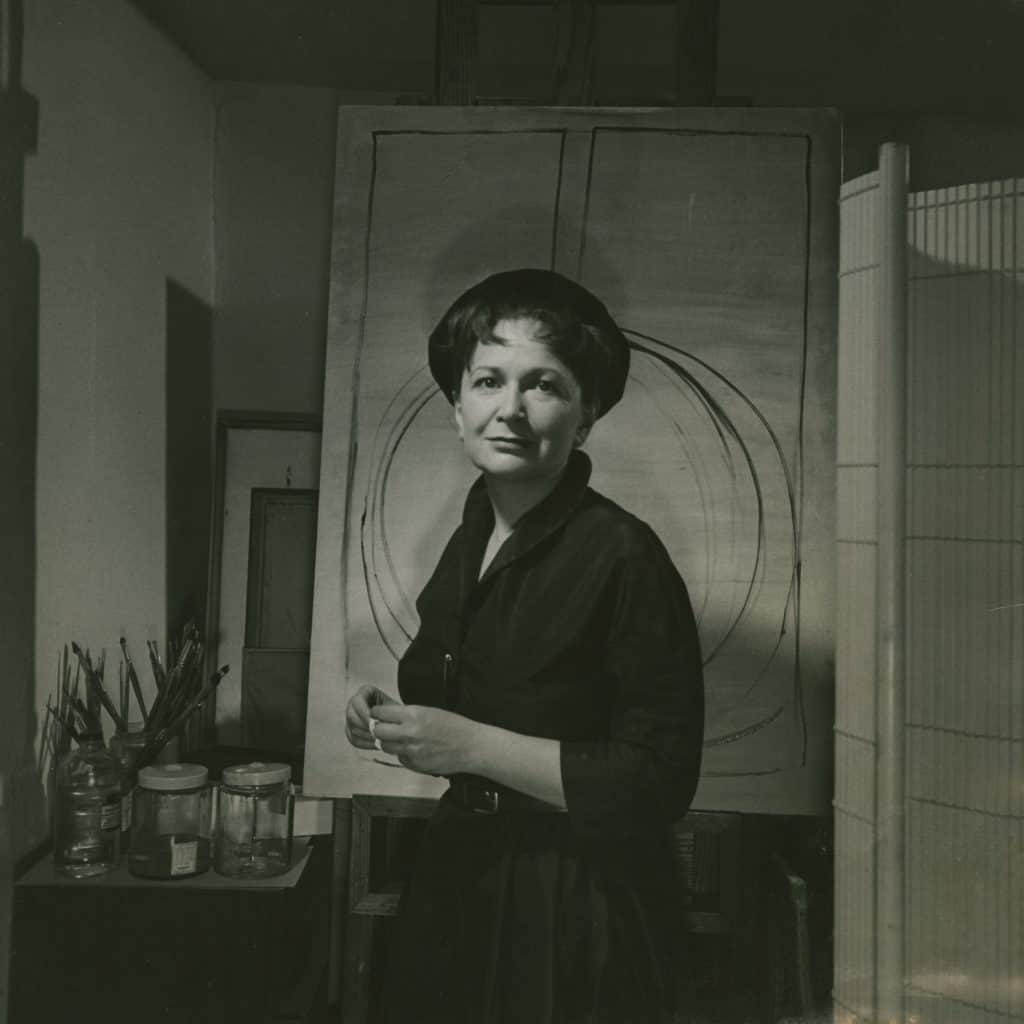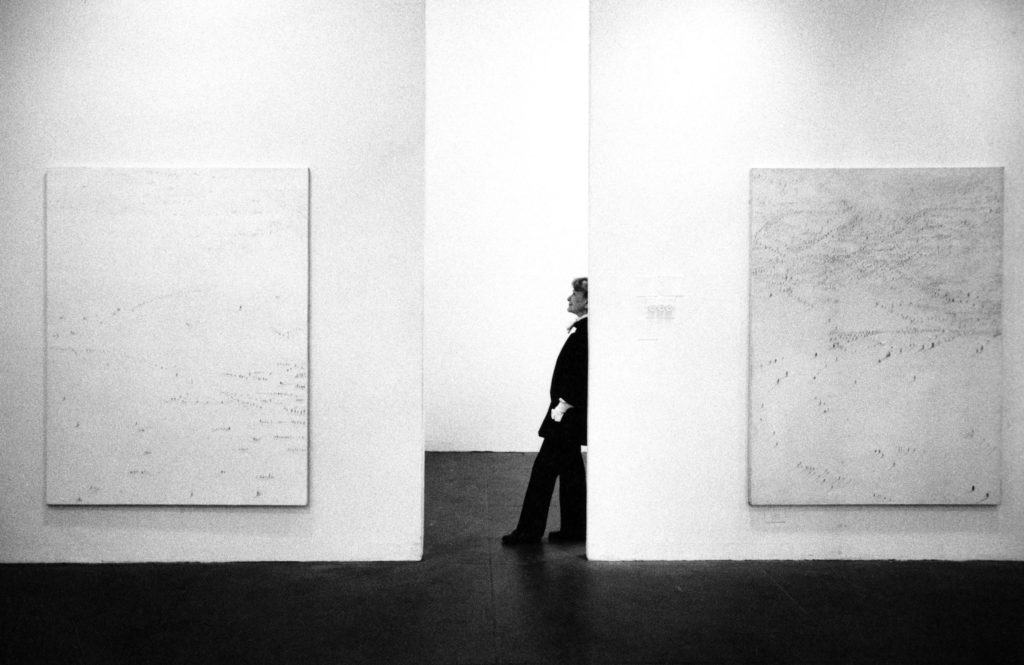Articles and Features
Female Iconoclasts: Hedda Sterne

By Lauren Gee
“I believe … that isms and other classifications are misleading and diminishing. What entrances me in art is what cannot be entrapped in words”
Hedda Sterne
In the annals of twentieth century painting there are many artists who are famous for their painting, and a handful of others who are simply famous. Most observers with a passing knowledge of The New York School are familiar with the storied names within it; a whose who of artists, consisting almost entirely of men, and the innovators of painting in that mid century period when New York assumed primacy over Paris for the first time. However, within this group there was woman artist known at the time for her fierce intellect and innovative work, but whose career is now obscured and current reputation reduced to a quiz question. Who is this sole woman artist depicted in ‘The Irascibles’ photograph, the image that was to become emblematic of an entire generation of seminal artists? The answer to this question is Hedda Sterne, a first generation abstract expressionist whose quiet and visionary approach to painting was to influence countless other artists until her death in 2011 at 100 years of age.
Early Life
Born August 4th, 1910 in Bucharest, Romania, Hedda Sterne grew up in a low income family, her father was a languages teacher and her mother was a housewife. From an early age Sterne was an ambitious young woman, learning to speak German, French and English and at the impressive age of eleven had read her way through Dostoevsky and Proust. Her family were musical; her brother studied the violin and went on to become a renowned conductor and Sterne was pushed to learn piano which she resisted, convincing her family to allow her to pursue art instead. Her childhood friend and artist Victor Brauner introduced Sterne to Constructivism and Surrealism, the combination of which would go on to inform her genre-breaking artistic career. In 1941 her family fled Bucharest as WWII shadowed the city in the form of the Jewish pogroms, departing for the United States where she would reside for the remainder of her life until her death in 2011 at the age of 100.
“It was just unbelievable. I had such an epiphany. I was changed for life by that show. I went back and had the urge, finally, to paint.”
Hedda Sterne commenting on the Chelsea Flower Show
Travel and studies
Sterne flew to London at the age of seventeen where she visited the Chelsea Flower Show, a pivotal influence for the young creative, where exposed to the colour and spectacle of the display she realised her love of art, precipitating an urge to paint. Following this revelation she visited Paris and Vienna from 1927 to 1932, taking classes at the ateliers of André Lhote and Fernand Léger, and at the Académie de la Grande Chaumière. Her education was not completed there, studying also at the University of Bucharest, where she read Philosophy and Art History.

Sterne’s Career
Sterne was heavily influenced by Surrealism in her early career, particularly the Surrealist practice of automatism, where the unconscious mind of the artist takes authority in the artistic process. It was with her ‘automatic’ collages that she achieved a breakthrough in international acclaim, when they were included in Paris exhibition, Les Surindépendants’ catching the eye of Jean Arp. In connecting with Arp, Sterne was recommended to Peggy Guggenheim, resulting in a flourishing relationship between the two women, with Sterne’s work featuring in five of Guggenheim’s exhibitions.
“Everything that was worthwhile was happening in Paris, and if you weren’t in Paris you were in exile.”
Hedda Sterne
Once in New York, Sterne was reunited with many of the Surrealist Painters she had become acquainted with in Paris, in addition to many new faces. She boldly established herself in the art scene in New York, leading to her works being included in the exhibition First Papers of Surrealism in 1942, organised by André Breton and Marcel Duchamp.
The stimulating metropolis of New York City influenced Sterne’s work greatly, its architecture and industrial skyline bringing a dynamic use of line to her later works. Experimentation took hold of Sterne’s practice in the 1950’s in which revised methods and materials saw the non-conventional use of aerosol spray paint and other commercial products become part of her artistic process. During this period Sterne was increasingly concerned with motion and light in an attempt to interpret the increasing speed of the world around her. These loose painterly works are highly atmospheric, characterised by organic forms and tones of nature organised in reductive bands reminiscent of light conditions and landscape. This new direction reflected the artists she was working amongst and associating with, perhaps most famously Jackson Pollock, Willem de Kooning and Robert Motherwell, with whom she was famously photographed alongside for Life Magazine in 1951.
By the 1950s, combining formal innovation with material experimentation in her use of commercial aerosol spray paint in he . Sterne is widely remembered for her appearance at this time in a now iconic photograph for Life magazine, published in 1951, of the ‘Irascibles’ – a group of artists who protested against the Metropolitan Museum of Art’s failure to include abstraction in its exhibitions of American art. Notably, she is the only woman in the image.

Sterne’s Legacy
Sterne continues to be a revered name, influenced by Abstract Expressionism, Constructivism and Surrealism, known and remembered for her work which refused to be labelled into any specific art taxonomy. Her art continues to be exhibited internationally most famously featuring in MoMA’s reinstallation of its permanent collection with her 1954 painting New York VIII .
Relevant sources to learn more
Learn more about Hedda Sterne at the Hedda Sterne Foundation
7 reasons to love Hedda Sterne
Hedda Sterne at MoMA
Hedda Sterne exhibition at Victoria Miro
